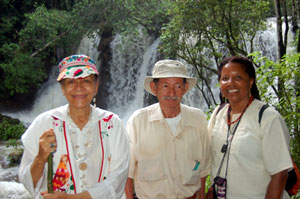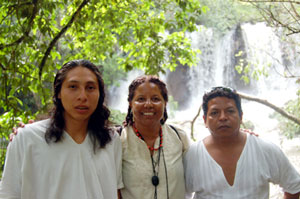Professor Toni-Mokjaetji Humber: Educational Guide for MXODUS Tours and African Diaspora in Mexico
More colmuns by Mother Tynnetta Muhammad

“And when We wish to destroy a town, We send commandments to its people who lead easy lives, but they transgress therein; thus the word proves true against it, so We destroy it with utter destruction. And how many generations did We destroy after Noah! And thy Lord suffices as being Aware and Seer of His servants’ sins.” –Holy Qur’an, Surah 17:16-17
On the outside lawn at the entrance of the Smithsonian Museum of Natural History in Washington, D.C., stands a replica of one of the gigantic sculpture heads of Mexico’s Olmec Mother Culture; with clearly defined features of the aboriginal Blackman of African and Asian origin, answers the question and answer we are given to study in the Student Enrollment of Who is the Original Man. This all bears witness to the Blackman’s ancient roots not only in Africa but all around the world. MXODUS Tours first initiated in the year 2006 and repeated in August 2007, pays homage to the universal history of the Blackman and family.

With profound gratitude, we wish to acknowledge the great scholarship and contributions made in organizing this tour to Professor Toni-Mokjaetji Humber whose exhaustive efforts made this tour possible. Complementing her words that are recorded in this closing article on the MXODUS Tour, we begin with a brief statement of one of her august colleagues and teachers, the late Asa G. Hilliard, III. “African people around the globe are in the midst of a Maafa. Maafa is a Kiswahilli term that means “disaster,” (Ani, 1989). It refers to the terroristic interruption of African civilization that was occasioned by European and Arab slavery and cultural aggregation.
“The Maafa we face is multi-faceted and complete. It has produced obvious horrors like enslavement, colonization, murder, the stealing of land and property, and the systematic social, political and economic domination of Africans and African society. It has also produced less obvious, but just as detrimental, horrors like cultural genocide, historical memory loss, and spiritual emptiness. While the Maafa continues to rage around us, we sleep; we fail to confront our condition as a unified people because we are ignorant of our past; we have no vision for the future, and we are reactionaries. In short, we do nothing as others make and execute plans for our future.” Now, we will have a few words from Dr. Toni-Mokjaetji Humber:
‘Once again it was indeed my honor to co-lead The MXODUS Tour of The African Diaspora in Mexico with you, my sister. We had an incredible journey and a rare privilege to travel through the mystical land of Mexico in search of the African presence, both ancient and modern. We witnessed Mexico’s dynamic history that encompasses the ancient Indigenous past, the destruction of Indigenous nations by the Spanish, as well as the Maafa, the African Holocaust and enslavement of Africans by the Spanish.

‘Our journey led to five pyramid/archaeological zones: Tajin in Veracruz; La Venta in Tabasco; and Palenque, Bonompak, and Yaxchilán in Chiapas. We walked through the lands of the Olmecs, Totonocs, and Mayas and witnessed the powerful cascading waters at Aqua Azul. In between these magnificent sites, we interacted with Mexicans whose roots go back to the ancients as well as to slavery. We celebrated at the annual Festival de Negritud with the community of Yanga, named for Gaspar Nyanga, the courageous enslaved African from Gabon who became a revolutionary and was America’s first liberator from a European colonizer.
‘At the festival, we sang La Historia de Yanga/The Story of Yanga, composed by me, to pay homage to this unsung hero of the Americas. We felt the rhythms and the heart beats of Africa in cultural celebrations and in the daily lives of Mexicans. We ate food, heard music, and saw the dances that were the result of African cultural influences. We felt a deep kinship with Mexican people, and many of their faces and countless artifacts and monuments from the distant past mirrored the face of Africa.
‘For me, a special highlight of the tour was to witness the magnificent Mayan frescoes at Bonampak in Chiapas. Upon witnessing these images on the walls of the temple, I clearly saw a connection between Mexico and Kemet. For those who deny the possibility of African contact in the Americas before the discovery, contact, and the cultural devastation rendered by European colonization, they need only to see the dark brown and black skin tones of the Maya in those frescoes to understand that Africans, indeed, were integral to Indigenous Americans. They were Indigenous Americans, too!
‘We, the Yanga Family, came away from this journey with the realization that the complex forces that forged African Americans in the United States were some of the same forces that forged the dynamic peoples of Mexico and the Americas. We, Africans in the Americas, are Indigenous people from Africa and from ancient Indigenous Americans. The depth of Africa’s impact in the Indigenous populations in the Americas has yet to be fully uncovered and realized, and the depth of Africa’s influence in all of the Americas has yet to be admitted. However, The MXODUS Tour of The African Diaspora in Mexico provides a great beginning to uncover the African influence in Mexico that has been hidden and obscured, and it enables us to put more pieces of the puzzle together to reveal the dynamic impact and face of African peoples in the Americas.
‘It is my hope that we will have an opportunity to journey to Mexico again in 2008; however, as you know, the recent floods in the state of Tabasco have been devastating and have caused Katrina-like conditions for many. They also have affected some of the Olmec and other archaeological sites we visit. I pray that those interested in helping these communities in any way possible will do so. After all, this ancient land is our land too!
‘I look forward to another incredible journey with you and my sisters and brothers in the Nation. May we continue to endarken others to see the light of African greatness and genius manifested in the dynamic peoples of the Americas! Ashé!!!’”
“Whoso desires this transitory life, We hasten to him therein what We please for whom0soever We desire, then We assign to him the hell; he will enter it despised, driven away. And whoso desires the Hereafter and strives for it as he ought to strive and he is a believer–those are they whose striving is amply rewarded. All do We aid–these as well as those–out of the bounty of thy Lord and the bounty of thy Lord is not limited.” —Holy Qur’an, Surah 17:18-20












